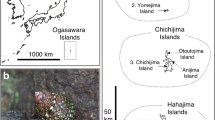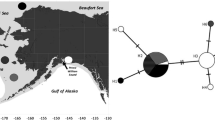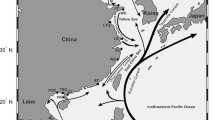Abstract
Population genetic studies of marine species sometimes find no clear patterns of genetic differentiation, but signals of geographic gene flow typified by isolation by distance (IBD) due to high dispersal ability. A previous study of mitochondrial DNA of the yellowfin goby Acanthogobius flavimanus indicated that this species also does not have clearly differentiated population groups around the Japanese archipelago, in contrast with other coastal goby species that have highly differentiated groups between the Sea of Japan and Pacific Ocean populations. Here, to clearly reveal phylogeographic structures of the yellowfin goby around the Japanese archipelago, we conducted large-scale RAD-sequencing analysis of their nuclear genomic SNP loci. As a result, IBD patterns were confirmed across the yellowfin goby populations, and the larval dispersal distance of this species was revealed to be approximately 19 km on average. In addition, different larval dispersal distances were estimated for its Sea of Japan and Pacific Ocean populations, suggesting that different coastal environments and/or ecological features may affect its dispersal rates. These results would provide foundations for ecological and conservation studies of the yellowfin goby and coastal fishes having similar dispersal strategy to this species.





Similar content being viewed by others
References
Akihito, Sakamoto K, Ikeda Y, Sugiyama K (2002) Suborder Gobioidei. In: Nakabo T (ed) Fishes of Japan with pictorial keys to the species, English edn. Tokai University Press, Tokyo, pp 1139–1310
Akihito, Fumihito A, Ikeda Y, Aizawa M, Makino T, Umehara Y, Kai Y, Nishimoto Y, Hasegawa M, Nakabo T, Gojobori T (2008) Evolution of Pacific Ocean and the Sea of Japan populations of the gobiid species, Pterogobius elapoides and Pterogobius zonoleucus, based on molecular and morphological analyses. Gene 427:7–18
Alexander DH, Lange K (2011) Enhancements to the ADMIXTURE algorithm for individual ancestry estimation. BMC Bioinformatics 12:246
Alexander DH, Novembre J, Lange K (2009) Fast model-based estimation of ancestry in unrelated individuals. Genome Res 19:1655–1664
Baltz DM (1991) Introduced fishes in marine systems and inland seas. Biol Conserv 56:151–177
Banks SC, Piggott MP, Williamson JE, Bové U, Holbrook NJ, Beheregaray LB (2007) Oceanic variability and coastal topography shape genetic structure in a long-dispersing sea urchin. Ecology 88:3055–3064
Binks RM, Byrne M, McMahon K, Pitt G, Murray K, Evans RD (2019) Habitat discontinuities form strong barriers to gene flow among mangrove populations, despite the capacity for long-distance dispersal. Divers Distrib 25:298–309
Bolger AM, Lohse M, Usadel B (2014) Trimmomatic: a flexible trimmer for Illumina sequence data. Bioinformatics:btu170
Brittan MR, Albrecht AB, Hopkirk JB (1963) An oriental goby collected in the San Joaquin River delta near Stockton, California. Cal Fish and Game 49:302–304
Brittan MR, Hopkirk JD, Conners JD, Martin M (1970) Explosive spread of the oriental goby Acanthogobius flavimanus in the San Francisco Bay-Delta region of California. Proc Calif Acad Sci 38:207–214
Catchen JM, Amores A, Hohenlohe P, Cresko W, Postlethwait JH (2011) Stacks: building and genotyping loci de novo from short-read sequences. G3-Genes Genom Genet 1:171–182
Dotsu Y, Mito S (1955) On the breeding-habits, larvae and young of a goby, Acanthogobius flavimanus (Temminck et Schlegel). Jpn J Ichthyol 4:153–161
Dotsu Y, Tsutsumi T (1959) The reproductive behaviour in the gobiid fish, Pterogobius elapoides (Günther). Rep Fac Fish Nagasaki Univ 8:186–190
Excoffier L, Smouse PE, Quattro JM (1992) Analysis of molecular variance inferred from metric distances among DNA haplotypes: application to human mitochondrial DNA restriction data. Genetics 131:479–491
Green AL, Maypa AP, Almany GR, Rhodes KL, Weeks R, Abesamis RA, Gleason MG, Mumby PJ, White AT (2015) Larval dispersal and movement patterns of coral reef fishes, and implications for marine reserve network design. Biol Rev 90:1215–1247
Haaker PL (1979) Two Asiatic gobiid fishes, Tridentiger trigonocephalus and Acanthogobius flavimanus, in southern California. Bull South Calif Acad Sci 78:56–61
Hirase S, Chambers S, Hassell K, Carew M, Pettigrove V, Soyano K, Nagae M, Iwasaki W (2017) Phylogeography of the yellowfin goby Acanthogobius flavimanus in native and non-native distributions. Mar Biol 164:106
Hirase S, Ikeda M (2014) Divergence of mitochondrial DNA lineage of the rocky intertidal goby Chaenogobius gulosus around the Japanese Archipelago: reference to multiple Pleistocene isolation events in the Sea of Japan. Mar Biol 161:565–574
Hirase S, Ikeda M, Kanno M, Kijima A (2012) Phylogeography of the intertidal goby Chaenogobius annularis associated with paleoenvironmental changes around the Japanese Archipelago. Mar Ecol Prog Ser 450:167–179
Hirase S, Kokita T, Nagano AJ, Kikuchi K (2019) Genomic and phenotypic consequences of two independent secondary contact zones between allopatric lineages of the anadromous ice goby Leucopsarion petersii. Heredity. https://doi.org/10.1038/s41437-019-0239-6
Hirase S, Takeshima H, Nishida M, Iwasaki W (2016) Parallel mitogenome sequencing alleviates random rooting effect in phylogeography. Genome Biol Evol 8:1267–1278
Kanou K (2004) Diet shift with settlement in the yellowfin goby Acanthogobius flavimanus at a tidal mudflat. La mer 41:67–72
Kanou K, Sano M, Kohno H (2005) Larval and juvenile fishes occurring with flood tides on an intertidal mudflat in the Tama River estuary, central Japan. Ichthyol Res 52:158–164
Kinlan BP, Gaines SD (2003) Propagule dispersal in marine and terrestrial environments: a community perspective. Ecology 84:2007–2020
Kitano J, Ross JA, Mori S, Kume M, Jones FC, Chan YF, Absher DM, Grimwood J, Schmutz J, Myers RM et al. 2009. A role for a neo-sex chromosome in stickleback speciation. Nature 461:1079–1083
Koike F, Iwasaki K (2011) A simple range expansion model of multiple pathways: the case of nonindigenous green crab Carcinus aestuarii in Japanese waters. Biol Invasions 13:459–470
Kokita T, Nohara K (2011) Phylogeography and historical demography of the anadromous fish Leucopsarion petersii in relation to geological history and oceanography around the Japanese Archipelago. Mol Ecol 20:143–164
Kokita T, Takahashi S, Kumada H (2013) Molecular signatures of lineage‐specific adaptive evolution in a unique sea basin: the example of an anadromous goby Leucopsarion petersii. Mol Ecol 22:1341–1355
Leaché AD, Banbury BL, Felsenstein J, De Oca AN-M, Stamatakis A (2015) Short tree, long tree, right tree, wrong tree: new acquisition bias corrections for inferring SNP phylogenies. Syst Biol 64:1032–1047
Luu K, Bazin E, Blum MG (2017) pcadapt: an R package to perform genome scans for selection based on principal component analysis. Mol Ecol Resour 17:67–77
Matsui S, Inui R, Kai Y (2014) Annotated checklist of gobioid fishes (Perciformes, Gobioidei) from Wakasa Bay, Sea of Japan. Bull Osaka Mus Nat Hist 68:1–25
Meirmans PG, Van Tienderen PH (2004) GENOTYPE and GENODIVE: two programs for the analysis of genetic diversity of asexual organisms. Mol Ecol Notes 4:792–794
Middleton M (1982) The oriental goby, Acanthogobius flavimanus (Temminck and Schlegel), an introduced fish in the coastal waters of New South Wales, Australia. J Fish Biol 21:513–523
Oba T, Kato M, Kitazato H, Koizumi I, Omura A, Sakai T, Takayama T (1991) Paleoenvironmental changes in the Japan Sea during the last 85,000 years. Paleoceanography 6:499–518
Palumbi SR (2003) Population genetics, demographic connectivity, and the design of marine reserves. Ecol Appl 13:S146–S158
Peterson BK, Weber JN, Kay EH, Fisher HS, Hoekstra HE (2012) Double digest RADseq: an inexpensive method for de novo SNP discovery and genotyping in model and non-model species. PLoS One 7: e37135
Pinsky ML, Saenz-Agudelo P, Salles OC, Almany GR, Bode M, Berumen ML, Andréfouët S, Thorrold SR, Jones GP, Planes S (2017) Marine dispersal scales are congruent over evolutionary and ecological time. Curr Biol 27:149–154
Puebla O, Bermingham E, McMillan WO (2012) On the spatial scale of dispersal in coral reef fishes. Mol Ecol 21:5675–5688
Ravinet M, Takeuchi N, Kume M, Mori S, Kitano J. 2014. Comparative analysis of Japanese three-spined stickleback clades reveals the Pacific Ocean lineage has adapted to freshwater environments while the Japan Sea has not. PLoS One 9:24
Shimizu M (1984) Fishes and shellfishes in Tokyo Bay (1). Aquabiology 30: 9-13
Sasaki T., Hattori J. (1969) Comparative ecology of two closely related sympatric gobiid fishes living in tide pools. Jap J Ichthyol 15:143–155.
Stamatakis A (2006) RAxML-VI-HPC: maximum likelihood-based phylogenetic analyses with thousands of taxa and mixed models. Bioinformatics 22:2688–2690
Stamatakis A (2006) Phylogenetic models of rate heterogeneity: a high performance computing perspective. Proceedings 20th IEEE International Parallel and Distributed Processing Symposium. IEEE, p 278
Stamatakis A, Hoover P, Rougemont J (2008) A rapid bootstrap algorithm for the RAxML web servers. Syst Biol 57:758–771
Suzuki N, Sakurai N, Sugihara T (1989) Development of eggs, larvae and juveniles of the oriental goby Acanthogobius flavimanus reared in the laboratory. Suisan Zoshoku 364:277–289
Teske PR, Golla TR, Sandoval-Castillo J, Emami-Khoyi A, van der Lingen CD, von der Heyden S, Chiazzari B, van Vuuren BJ, Beheregaray LB (2018) Mitochondrial DNA is unsuitable to test for isolation by distance. Sci Rep 8:8448
Tsutsumi T, Dotu Y (1961) The reproductive behavior in the gobiid fish, Pterogobius zonoleucus Jordan et Snyder. Bull Fac Fish Nagasaki Univ 10:149–155
Warton DI, Duursma RA, Falster DS, Taskinen S (2012) smatr 3—an R package for estimation and inference about allometric lines. Methods Ecol Evol 3:257–259
Acknowledgements
The authors thank Kyushu and Tokushima prefecture lodges of Japan Sport Fishing Foundation, local fishing tackle stores in Japan (Jyoshu-Ya Miyagino store, Point Tokushima store, Anguru Koyaura store, Otaru-fishing PAPA, Kameya-Tsurigu Matsue store), and R. Tabata, S. Hayasaka, and T. Mikekado for providing specimens. This work was supported by the Ministry of Education, Culture, Sports, Science, and Technology (KAKENHI 221S0002 and Project “Construction of the platform for intellectual cooperation”) and the Japan Society for the Promotion of Science (KAKENHI 18H02493, 16H06154, and 26850131).
Author information
Authors and Affiliations
Corresponding author
Additional information
Publisher's Note
Springer Nature remains neutral with regard to jurisdictional claims in published maps and institutional affiliations.
About this article
Cite this article
Hirase, S., Tezuka, A., Nagano, A.J. et al. Genetic isolation by distance in the yellowfin goby populations revealed by RAD sequencing. Ichthyol Res 67, 98–104 (2020). https://doi.org/10.1007/s10228-019-00709-6
Received:
Revised:
Accepted:
Published:
Issue Date:
DOI: https://doi.org/10.1007/s10228-019-00709-6




